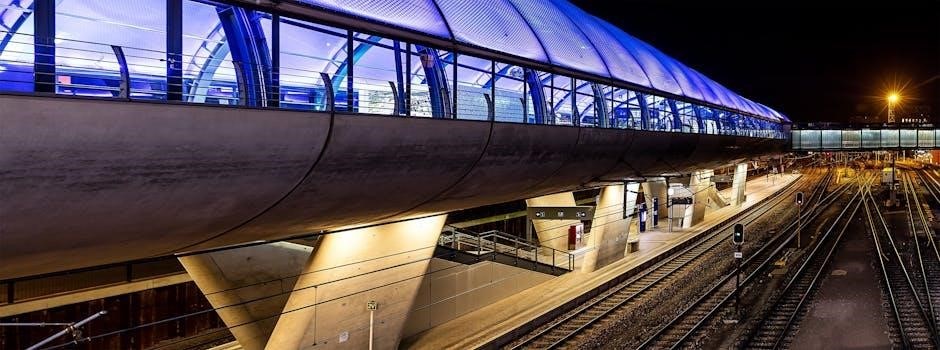Airport terminal design is a complex process balancing functionality, aesthetics, and efficiency. It involves understanding passenger flow, capacity needs, and cultural influences to create modern, sustainable gateways for air travel.
1.1. Overview of Airport Terminal Design
Airport terminal design integrates functionality, sustainability, and cultural aesthetics to create efficient gateways for air travel. Terminals must accommodate diverse passenger needs, ensuring seamless traffic flow and security. Modern designs emphasize energy efficiency, modular layouts, and biometric technology integration. Cultural influences and local heritage are often reflected in architecture, enhancing passenger experience. The design process involves master planning, capacity analysis, and adherence to international standards. Effective terminal design balances operational efficiency with passenger comfort, creating iconic structures that represent their regions while meeting future demands.

1.2. Evolution of Terminal Design Concepts
Terminal design concepts have evolved significantly, shifting from basic functional structures to sophisticated, passenger-centric hubs. Early terminals focused on essential operations, while modern designs prioritize efficiency, sustainability, and cultural expression. Technological advancements, such as biometric systems and automated processes, have transformed passenger experiences. The integration of green building practices and modular designs reflects a commitment to environmental sustainability. Additionally, the rise of iconic, award-winning terminals highlights the growing importance of aesthetics and cultural identity in airport architecture. This evolution ensures terminals adapt to growing traffic and changing passenger needs while maintaining operational excellence.
1.3. Key Considerations in Terminal Design
Key considerations in terminal design include capacity, traffic flow, and space requirements to ensure efficient passenger movement. Security and safety are paramount, with checkpoints and emergency preparedness integrated into layouts. Sustainability practices, such as energy efficiency and green certifications, are increasingly important. Cultural and local context should influence design to create a unique identity. Passenger experience, including amenities and accessibility, must be prioritized. Finally, adaptability and flexibility in design allow terminals to evolve with technological advancements and growing demand. These factors ensure terminals are functional, secure, and aligned with modern aviation needs.
Planning and Design Guidelines
Airport terminal planning involves adhering to FAA guidelines, ensuring capacity aligns with demand, and integrating local cultural influences while prioritizing sustainability and passenger-centric design principles.
2.1. FAA Advisory Circular (AC) 150/5360-7
The FAA Advisory Circular (AC) 150/5360-7 provides comprehensive guidelines for planning and designing airport terminal facilities. It addresses key considerations such as space allocation, passenger flow, and operational efficiency. The circular emphasizes the importance of aligning terminal design with projected demand, ensuring adequate capacity for peak periods. It also highlights the need for flexibility to accommodate future growth and technological advancements. By offering detailed frameworks, AC 150/5360-7 serves as a critical resource for airport planners and architects, helping them create functional, sustainable, and passenger-centric terminals that meet both current and future aviation needs while adhering to safety and regulatory standards.

2.2. Capacity, Traffic Flow, and Space Requirements
Capacity, traffic flow, and space requirements are critical in terminal design to ensure efficient operations and passenger comfort. Terminals are designed for design peak days (DPD) and design peak hours (DPH), reflecting anticipated traffic volumes. Passenger flow analysis determines optimal space allocation for check-in, security, and lounges. Capacity calculations balance current demand with future growth, ensuring terminals can adapt to increasing passenger numbers and evolving aviation needs while maintaining smooth traffic flow and adequate space for all functional areas, enhancing overall efficiency and user experience.
2.3. Local Context and Cultural Influence in Design
Local context and cultural influence play a pivotal role in shaping terminal design. Airports often reflect the region’s heritage through architectural elements, materials, and artwork. For example, Helsinki Airport’s design incorporates Finnish aesthetics, while Guwahati’s terminal showcases regional culture. Engaging local communities ensures the design resonates with residents and visitors alike. Compliance with local standards and regulations is also crucial, ensuring terminals are functional and culturally relevant. This integration enhances passenger experience, creating a unique identity that distinguishes one airport from another, while maintaining practicality and efficiency, making the terminal a gateway that honors its locale.

Terminal Layout and Configuration
Terminal layout and configuration involve strategic planning to optimize passenger flow, operational efficiency, and space utilization, ensuring seamless connectivity and accessibility for all users.

3.1. Centralized vs. Decentralized Terminal Models
Centralized terminal models consolidate facilities under one roof, simplifying passenger navigation and transfers, while decentralized models spread operations across multiple buildings, reducing congestion during peak times. Both designs prioritize efficiency but cater to different airport sizes and traffic patterns. Centralized models are ideal for large hubs with high transfer traffic, offering streamlined processes. Decentralized models, often seen in smaller airports, allow for modular expansion and adaptability. The choice between them depends on specific operational needs, passenger volume, and future growth plans, ensuring optimal functionality and user experience.
3.2. Pier-Semicircular Layout with Satellite Concourses
The pier-semicircular layout with satellite concourses is a popular terminal design, offering efficient traffic management and passenger flow. The main terminal acts as a central hub, with piers extending outward and connecting to satellite concourses. This configuration allows for seamless aircraft docking and reduces taxiing distances. It is particularly effective for handling large volumes of traffic and provides flexibility for future expansion. The design enhances passenger convenience by minimizing walking distances and offering clear wayfinding. Satellite concourses can be tailored for specific uses, such as international flights, further improving operational efficiency. This layout balances functionality with aesthetic appeal, creating a modern and efficient airport experience.
3.3. Open-Gate Terminals for Peak Traffic Management
Open-gate terminals are designed to efficiently manage peak traffic by optimizing gate utilization and reducing congestion. This layout eliminates fixed assignments, allowing gates to be shared dynamically among airlines. During peak periods, multiple flights can be accommodated without delays, enhancing operational flexibility. The design minimizes walking distances for passengers and streamlines aircraft movements; Open-gate terminals are particularly beneficial for airports with fluctuating demand, as they adapt to varying traffic loads. This approach not only improves efficiency but also supports cost savings and better resource allocation, making it a strategic choice for modern airports seeking to enhance capacity and passenger satisfaction.
Security and Technology Integration
Modern airport terminals integrate advanced security systems and biometric technologies to enhance passenger safety and streamline processes, ensuring efficient and secure travel experiences while adapting to emerging threats.
4.1. Security Checkpoints and Passenger Screening
Security checkpoints are critical in terminal design, ensuring passenger and staff safety while maintaining efficiency. Advanced technologies like CT scanners and automated ID verification systems streamline screening processes. Biometric integration enhances identity verification, reducing bottlenecks. Designed with clear signage and intuitive layouts, checkpoints minimize stress and confusion for travelers. Retrofitting existing terminals with modern screening systems is essential for compliance with evolving security standards; Balancing thorough screening with seamless passenger flow remains a key challenge in terminal design, requiring careful planning and continuous technological upgrades to address emerging threats and operational demands;
4.2. Biometric Technology in Terminal Design
Biometric technology is revolutionizing airport terminals by enhancing security and passenger experience. Facial recognition, fingerprint scanning, and iris recognition systems are being integrated to streamline identity verification processes. These technologies reduce wait times, eliminate the need for physical documents, and provide seamless navigation through checkpoints and gates. Biometric solutions also improve security by accurately identifying individuals and flagging potential threats. As data privacy concerns grow, terminals must ensure secure handling of biometric information. The adoption of biometric technology is becoming a cornerstone in modern terminal design, offering efficient, secure, and personalized travel experiences for passengers worldwide.
4.3. Emergency Preparedness and Response Planning
Effective emergency preparedness and response planning are critical in terminal design to ensure passenger and staff safety. This involves developing comprehensive emergency response plans, including evacuation routes, communication systems, and emergency exits. Regular drills and training programs for airport staff are essential to maintain readiness. Advanced technologies, such as emergency management software, are integrated to coordinate responses efficiently. Collaboration with local authorities and first responders is also vital to streamline operations during crises. A well-designed terminal ensures that safety protocols are seamlessly integrated into its layout, minimizing risks and enhancing overall resilience. Preparedness is a cornerstone of modern terminal design.

Cultural and Aesthetic Considerations
Airport terminals often reflect local heritage and cultural identity through architectural design, art installations, and regional aesthetics, creating unique passenger experiences that resonate with the surrounding community.
5.1. Reflecting Local Heritage in Terminal Design
Airport terminals increasingly incorporate local cultural and historical elements to create a sense of place and identity. This approach enhances passenger experience by showcasing regional art, architecture, and traditions. For instance, terminals like Helsinki Airport feature designs inspired by Nordic landscapes, while others integrate traditional materials or symbolic motifs. Such practices not only foster cultural pride but also provide a unique ambiance, making terminals memorable landmarks. By blending heritage with modern functionality, airports achieve a harmonious balance between aesthetics and operational efficiency, ensuring a lasting impression on travelers.
5.2. Architectural Awards and Iconic Terminals
Iconic airport terminals often earn architectural accolades for their innovative designs. Helsinki Airport, for instance, won the Prix Versailles 2022 for its stunning architecture. Similarly, FosterPartners’ design for Abha International Airport highlights cultural and regional influences. These terminals showcase exceptional design, blending functionality with aesthetic appeal. Awards like the Prix Versailles recognize airports that excel in integrating art, culture, and sustainability. Iconic terminals become landmarks, reflecting a city’s identity while setting new standards in airport design and passenger experience. They inspire future projects, driving innovation in the aviation architecture field.
5.3. Passenger Experience and Amenities
Passenger experience is central to modern terminal design, with amenities tailored to comfort and convenience. Airports now feature spacious lounges, diverse dining options, and seamless digital check-in systems. Biometric technology streamlines security and boarding, reducing wait times. Cultural and local elements, such as art installations and regional cuisine, enhance the travel experience. Amenities like free Wi-Fi, charging stations, and relaxation zones cater to diverse passenger needs. These elements collectively create a welcoming environment, ensuring a positive journey from arrival to departure. The focus is on balancing efficiency with comfort, making air travel more enjoyable for all passengers.
Sustainability and Green Building Practices
Sustainable terminal design incorporates energy-efficient systems, renewable materials, and green certifications, ensuring environmentally responsible airport development while reducing operational costs and carbon footprint.
6;1. Energy Efficiency in Terminal Design
Energy efficiency is a cornerstone of modern terminal design, reducing operational costs and environmental impact. Strategies include natural lighting, solar panels, and geothermal systems. Airports like Helsinki and Seattle-Tacoma integrate these technologies, achieving significant energy savings. Advanced HVAC systems and smart building controls optimize energy use, while green certifications like LEED encourage sustainable practices. These designs not only enhance passenger comfort but also align with global environmental goals, making terminals eco-friendly and resilient for future needs.
6.2. Green Building Certifications for Airports
Green building certifications like LEED, BREEAM, and Green Globes recognize airports for sustainable design and energy efficiency. These certifications assess factors such as energy use, water conservation, and material selection. Achieving these standards enhances an airport’s reputation and aligns with global sustainability goals. Many modern terminals now pursue these certifications to demonstrate their commitment to environmental responsibility, ensuring they meet rigorous criteria for eco-friendly operations and design.
6.3. Modular and Adaptive Design for Future Needs
Modular and adaptive design strategies enable airports to expand and evolve efficiently. These approaches allow terminals to be constructed in phases, accommodating future growth without disrupting operations. Adaptive designs incorporate flexible spaces that can be repurposed as needs change, such as converting check-in areas to self-service kiosks. Modular construction also reduces costs and environmental impact by using prefabricated components. This forward-thinking approach ensures terminals remain functional and relevant, adapting to technological advancements and increasing passenger demand without requiring major overhauls.

Case Studies and Examples
Iconic terminals like Helsinki Airport and Foster+Partners’ Abha design showcase innovative approaches, blending sustainability, cultural elements, and passenger-centric features, setting benchmarks for future airport design.
7.1. Award-Winning Terminal Designs Worldwide
Award-winning terminals like Helsinki Airport and Foster+Partners’ Abha International Airport design exemplify innovation. Helsinki’s terminal, recognized in Prix Versailles 2022, blends Nordic aesthetics with functionality. Similarly, the proposed phoenix-inspired terminal at Phu Quoc International Airport highlights cultural symbolism. These designs showcase sustainability, passenger-centric amenities, and local cultural integration, setting global benchmarks. They demonstrate how terminals can serve as iconic gateways, reflecting regional identity while addressing modern aviation needs. Such projects inspire future designs, emphasizing the importance of creativity and functionality in airport architecture.
7.2. Regional Airport Terminal Design Solutions
Regional airports often prioritize modular, adaptable designs to meet specific local needs. For instance, New Plymouth Airport’s Te Hono terminal blends cultural heritage with modern functionality. Similarly, Guwahati’s new terminal reflects regional aesthetics while enhancing efficiency. These designs emphasize cost-effectiveness, scalability, and integration of local materials. They also focus on passenger comfort and operational simplicity. such solutions ensure smaller airports can thrive, offering tailored experiences that resonate with their communities while maintaining global aviation standards. These examples highlight the importance of context-sensitive design in creating functional yet distinctive regional terminals.
7.3. Lessons Learned from Successful Projects
Successful terminal designs emphasize adaptability, cultural integration, and sustainability. Helsinki Airport’s award-winning design showcases natural light and local materials, enhancing passenger experience. Similarly, the new terminal at Guwahati Airport blends regional aesthetics with modern efficiency. These projects highlight the importance of modular design, allowing future expansions. Biometric technology and green building practices, as seen in New York’s Terminal, demonstrate how innovation can improve security and environmental performance. Such examples provide valuable insights, proving that terminals must balance functionality, aesthetics, and cultural identity to meet evolving passenger needs and operational demands effectively.

Future Trends in Terminal Design
Future trends include automation, biometric integration, and adaptive modular designs, enhancing efficiency and passenger experience while incorporating cultural and aesthetic elements seamlessly into modern terminals.
8.1. Automation and Digital Transformation
Automation and digital transformation are revolutionizing terminal design, enhancing efficiency and passenger experience. Biometric technologies, such as facial recognition, streamline security and boarding processes, reducing wait times. Self-service kiosks and mobile check-ins minimize queues, while AI-driven systems optimize resource allocation and predictive maintenance. Digital wayfinding and real-time data integration improve navigation and operational decision-making. These advancements not only modernize terminals but also align with sustainability goals by reducing energy consumption and enhancing resource utilization, creating smarter, future-ready airports.
8.2. Multi-Disciplinary Approaches to Terminal Planning
Effective terminal planning requires a multi-disciplinary approach, integrating expertise from architects, engineers, urban planners, and aviation experts. This collaborative method ensures terminals are functional, sustainable, and culturally relevant. By combining technical knowledge with passenger-centric design, terminals can address complex challenges like capacity, security, and environmental impact. Such approaches also foster innovation, enabling airports to adapt to future demands while maintaining operational efficiency and passenger satisfaction. This holistic strategy is essential for creating modern, resilient, and user-friendly terminals that meet the evolving needs of air travel. Collaboration ensures seamless integration of design, technology, and user experience.
8.3. The Role of Master Plans in Terminal Development
Master plans play a pivotal role in guiding terminal development by outlining long-term visions and strategic goals. They ensure cohesive growth, aligning infrastructure with future demands while addressing operational, financial, and environmental considerations. These plans are comprehensive blueprints that integrate land use, transportation, and facility expansion, providing a clear roadmap for stakeholders. Regular updates to master plans allow terminals to adapt to emerging trends and technologies, ensuring resilience and sustainability. By prioritizing flexibility and scalability, master plans are instrumental in creating airports that meet current needs while anticipating future challenges, fostering efficient and sustainable terminal evolution over time.
Effective terminal design balances sustainability, functionality, and cultural aesthetics, ensuring seamless passenger experiences and adaptability for future aviation demands.

9.1. Summary of Key Design Principles
Airport terminal design must balance functionality, aesthetics, and sustainability. Key principles include optimizing passenger flow, ensuring energy efficiency, and incorporating cultural influences. Sustainable practices, such as green building certifications, are essential. Designs should reflect local heritage while providing modern amenities. Passenger-centric layouts prioritize comfort and accessibility. Adaptive and modular designs allow for future expansion. Security and technology integration are critical for safety and efficiency. FAA guidelines and global best practices should guide the process. Ultimately, successful terminal design enhances the passenger experience while addressing operational and environmental needs.

9.2. The Importance of Continuous Improvement
Continuous improvement is vital in airport terminal design to adapt to evolving passenger needs and technological advancements. Regular assessments ensure facilities remain efficient and safe. By incorporating feedback from users and stakeholders, designs can be refined. Sustainability practices must be updated to meet new environmental standards. Integrating emerging technologies, like biometrics, enhances security and passenger experience. Stay informed about global trends and best practices to maintain competitiveness. Proactive planning ensures terminals are resilient to future challenges, making continuous improvement a cornerstone of successful airport design and operation.
9.3. Looking Ahead in Terminal Design Innovation
Future terminal design will focus on automation and digital transformation, integrating biometric technology for seamless passenger experiences. Modular and adaptive designs will enable flexibility, accommodating future growth and changing demands. Sustainability remains a priority, with green building practices and energy-efficient solutions leading the way. Incorporating local cultural influences will enhance passenger satisfaction while maintaining global standards. Master plans will guide long-term development, ensuring terminals evolve with technological advancements. Continuous innovation in materials, layouts, and operational systems will redefine airport terminals, making them more efficient, secure, and passenger-centric.

Write Reviews
Leave a Comment
No Comments & Reviews